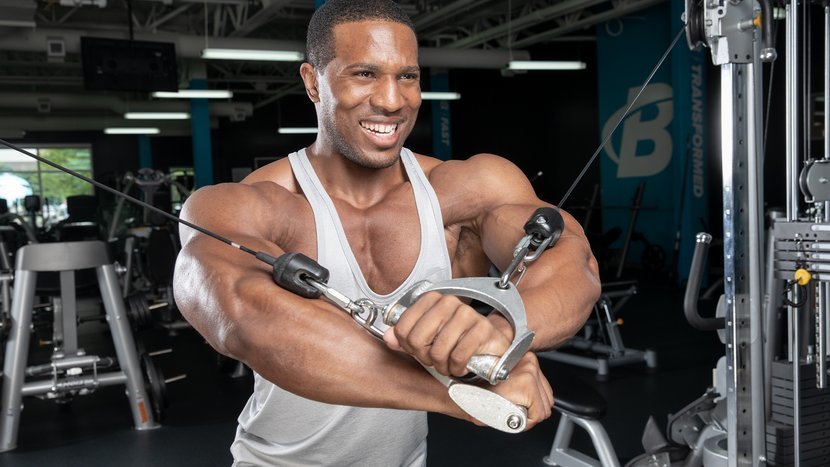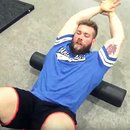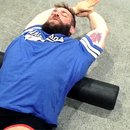Manual therapists and athletes often blame shoulder pain and/or dysfunction on one central cause. Usual suspects include tight pecs or lats, or weak rhomboids. From there, they focus solely on addressing that single factor. Unfortunately, that problem may not be the problem at all, or it might be only one of several factors at work.
One overlooked cause of shoulder issues is the thoracic spine, comprising the 12 vertebra lying below the cervical spine and above the lumbar spine. With a little detective work, many problems with shoulder mobility can actually be traced to this section of the spine, which may be suffering from dysfunction resulting from poor posture or muscle imbalances.
The goal of this article is to make sure your shoulders aren't suffering because of problems with thoracic spine mobility; and, if they are, to correct the problem.
How Spine Biomechanics Connect to Shoulder Pain
The primary functions of the thoracic spine are flexion (the forward movement) and extension (the backward movement). Most people spend a majority of their day in flexion—talking to you here, desk jockeys—with a rounded upper back. Because your ribs are connected to your thoracic vertebra, chronic flexion-induced dysfunction in this area eventually trickles out to the shoulder blades and then to the shoulders themselves.
Since we don't want to reinforce flexion in this way, we will be trying to break out of that pattern by going into extension with these drills.
If you're still sitting down, I want you to twist your torso to either side. Now you've performed the other major function of the thoracic spine: rotation. (Issues here often hit athletes who play sports—like golf, volleyball, or baseball—with a heavy emphasis on thoracic rotation.)
Your ribs have insertions—connection points, basically—at the front of the sternum. So while the ribcage is a rigid, protective structure, it has to be able to move enough to allow for the expansion of the lungs during breathing. The insertion points also accommodate integrated, global rotation of the hips, trunk, and shoulders. Making sure the thoracic spine can rotate adequately will ensure that you don't place greater demands of undue rotation on the shoulders.
So now that you understand the problems, I'm going to give you some drills that improve your thoracic spine mobility and, by extension, also improve your shoulder health and minimize injury. The goal here is functional, pain-free shoulders.
Thoracic Mobility Drills to Help with Shoulder Pain
I like integrating these drills on bench day:

BodyFit
$6.99/month- 2,500+ expert-created single workouts
- 3,500+ how-to exercise videos
- Detailed workout instruction
- Step-by-step workout tips
- Training at gym or at home
- Access to Workout Plans
- Access to Bodyfit App
- Store Discounts
Already have a Bodybuilding.com account with BodyFit? Sign In

What comes with BodyFit?

- Instructional Videos
Don't risk doing a workout improperly! Avoid injury and keep your form in check with in-depth instructional videos.

- How-to Images
View our enormous library of workout photos and see exactly how each exercise should be done before you give it a shot.

- Step-by-Step Instructions
Quickly read through our step-by-step directions to ensure you're doing each workout correctly the first time, every time.

Technique Tips
Foam Roller Thoracic Extension
This helps with thoracic extension. Place the foam roller behind you and perpendicular to your body. Lie down so that the foam roller sits right on the apex, or highest point, of your mid back. Keep your hips down and butt touching the floor. Raise your hands up over your head and keep your ribs and chin tucked as you lie back, creating a fulcrum right at that apex of your thoracic spine. Extension should come from the thoracic spine, NOT the lumbar spine.
Dumbbell Pull-over
This is another extension drill. Set up with the apex of your thoracic spine on the edge of a bench. Plant your feet in front of you with your hips hovering off the ground, as if you are about to do a hip raise. Grab one end of a dumbbell with both hands and load it over your head. Externally rotate your shoulders and make sure your elbows stay tucked as you lower the dumbbell behind you. Feel the weight pulling you into extension far enough while still keeping your rib cage down and not extending at the lumbar spine. Raise the dumbbell back up above your head and repeat.
Thread the Needle (with Foam Roller)
This one's a rotation drill. Assume a quadruped position and place the foam roller parallel to you on the outside of your body. Reach the hand opposite of the foam roller underneath your chest and rest it on top of the roller with your palm facing inward.
Gently reach farther and farther out with that hand, thinking about driving your elbow down as you push the roller out. This will create rotation in the thoracic spine. Keep your knees and hips neutral—if they start to rotate along with you, this means that your lumbar spine is also rotating, which we do not want.
Band-Resisted Thread the Needle
Here's another rotation drill. Anchor a band to a rig or a bench. From a half kneeling position with your outside knee up, stretch the band across your body and place it into the crease of your outside shoulder. Then, stretch the band up and over your head so that it's resting on your traps. Get down into a quadruped position and perform the same thread-the-needle motion with the banded shoulder, reaching underneath your body toward the anchor point of the band. Once you've gone as far as you can, reverse the motion back and open up the chest in the opposite direction, rotating the thoracic spine as you reach your hand skyward. Repeat this motion.





